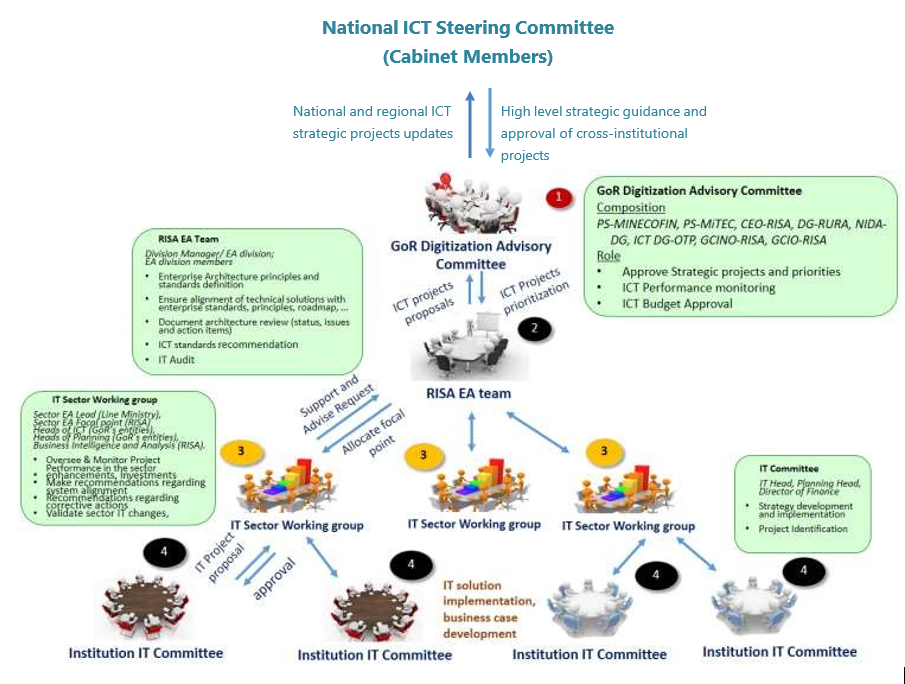EA Governance Implementation
The purpose of the EAG Framework is to provide policy guidance and advice and assistance in the definition, design, and implementation of Enterprise Architecture (EA) discipline and practice throughout the organization.
In addition, it serves as the core governance asset providing advocacy for EA integration of business and technology architectures across business units as well external boundaries.
The EAG establishes common terminology definitions and frameworks, including the Enterprise Architecture Framework and Technical Reference Models and Standards; and practical guidance to effectively implement and provide assurance for government of Rwanda technology solutions required to enable business requirements.
The Implementation of any EAG follows a number of steps. Typically, EAG requires formation of a number of governing bodies that share responsibility of overseeing operations of the IT functional unit.
These bodies are systematically arranged along the System Development Lifecycle (SDLC) to not only set and ensure adherence to set standards and principles but also to mitigate the risk of IT delivering a solution that may potentially be misaligned to the business requirements. Furthermore, the governance bodies vet and make recommendations on future IT investment plans.
The rationale behind having multiple governance bodies is to avoid a situation where a single body is entrusted with the responsibility of both making recommendation and approving the same. Best practice requires that there be multiple bodies that will validate each other’s decision.
Within the Government of Rwanda, however, it has been noted that the IT functional units are relatively small. In the majority of cases, the IT team is composed of less than ten (10) FTEs.
This scenario makes it impossible to create multiple IT governance bodies in such organizations.
It is, however, still imperative that EA governance be instituted in all public entities. It is noted that all public entities have and IT committee whose terms of reference include making decisions for IT investment and operational enhancements.
It is proposed that the terms of reference for such a committee should be extended to includenterprise architecture governance.e. In this regard, the IT committee should also have the responsibility of ensuring adherence to set standards and application of EA policies.
If, however, this IT Committee is to be the only body responsible for making decision affecting an entity, governance would be a failure in principle for the following reasons:
- The IT Committee’s decisions need to be vetted by another independent body
- The government of Rwanda’s goal of bringing integration between public entities will need to be driven by a common goal across all public entities and therefore needs another body outside each of the entities to validate the decisions that would impact the integration
Since all the entities are organized in Sectors, it is therefore recommended that the IT committees for each entity be aligned to their respective Sectors. At central level, three additional decision making bodies will serve as escalation points for institutions’ IT committees and Sector Working Groups. These are:
- RISA Team
- GoR Digitization Advisory Committee
- National ICT steering committee.
Described below is the proposed relationship:
- The IT Committee will be responsible for making IT decisions for the respective public entity. These decisions will include future investment plans, system enhancements, solution development, etc.
- Before the decisions are implemented, the IT Sector Working Group should be consulted. This is because the IT Sector Working Group would have a clear view of how each of the entities’ architecture fits in with the sector mandate. In order to ensure that there is no disruption to the integration plans, the IT Sector Working Group will be the custodian of the sector architecture models. As such, it would be in a better position to approve decisions that would not compromise the integrations across sector entities.
- In making its decision, the IT Sector Working Group will liaise with the RISA-EA Team. The RISA EA Team is responsible for setting architecture standards and policies for all
- government entities. As such, it will vet decisions made by IT Sector Working Groups in line with the set standards,policies,s and architecture goals of the government.
- All major IT investment plans will be approved by the GoR Digitization Advisory Committee via the RISA-EA Team.
- All strategic orientations in connection to ICT cross-institutional projects fall under the responsibility of the National ICT steering committee, which is composed of GoR’s cabinet members.
The roles and compositions of each of the governance groups are depicted below.

